Why We Need to Raise the Profile of Lower-Limb Amputation Research Now
There are 2.1 million people living with limb loss in the U.S. And each year, over 150,000 individuals undergo lower-limb amputation. However, we don't know enough to help people with lower-limb loss improve their quality of life. Experts suggest this lack of research is due to the lack of attention and resources caused by prioritizing revascularization or limb salvage.

Dan Carradice, vascular surgical specialty lead for the Royal College of Surgeons of England, emphasizes in Vascular News that although it is crucial to try and save limbs, limb revascularization may not be beneficial for certain patients. In such cases, amputation surgery may lead to better patient outcomes.
The issue is with how most surgeons perceive amputation. Many surgeons see it as a surgical failure, but for many patients, it is a successful treatment.
But the good news is, this mindset is shifting. Shigong Guo, a rehabilitation medicine consultant at the North Bristol NHS Trust in the U.K., stated that the previous mentality of prioritizing limb preservation at all costs has recently evolved. In an interview with Vascular News, he emphasized that while clinicians must prioritize preserving the functionality of the limb, it mustn't be at the expense of those who require amputation.
This mindset shift is an essential first step to helping patients improve their quality of life. Because for the patient, this "failure" point marks the beginning of the next significant part of their life. At this stage, their lifestyle will be drastically different from what they are accustomed to, and they will require extensive support from healthcare providers and, of course, research.
The loss of a lower limb has a significant impact on a person's life. The initial amputation can be a traumatic experience, and many individuals continue to face challenges and limitations. For instance, using a prosthetic limb can be uncomfortable and challenging, affecting their ability to exercise, work, or move around.
This is where better research and community awareness of amputation and its effects come in—it can lead to a better quality of life for more individuals with limb loss.
Unfortunately, research on lower limb amputation is currently lacking the necessary funding and prioritization. As a result, there is a shortage of resources available for developing new treatments, technologies, and interventions that could positively impact the outcomes for patients in this population.
So, what can be done?
First, researchers need to secure more funding. In the U.K., researchers are applying for funding to conduct a trial comparing through-knee with above-knee amputation for people who are unsuitable for below-knee amputation. The study will focus on examining patients' quality of life and could encourage further research. Healthcare providers in the U.K. hope this study will bring about positive changes for lower-limb amputees.
Second, researchers, healthcare providers, and patient advocacy groups must collaborate and coordinate. This could lead to better sharing of knowledge and resources, as well as better patient outcomes and quality of life.
According to Guo, they hope the study on through-knee amputation will be done in collaboration and joint funding with the Australian National Health and Medical Research Council. A collaborative effort at an international scale could increase the focus on amputation research globally and inspire other related studies.
Lastly, raising awareness of lower-limb amputation is crucial in fighting against the discrimination and stigma that lower-limb amputees often encounter. Educating the public can also result in more advocates who can draw attention to this issue.
It is projected that the number of people living with limb loss in the U.S. will increase to 3.6 million by 2050, mainly due to diabetes-related vascular complications. By dedicating more attention and resources to this issue now, we have the power to improve the lives of millions of Americans.











































































